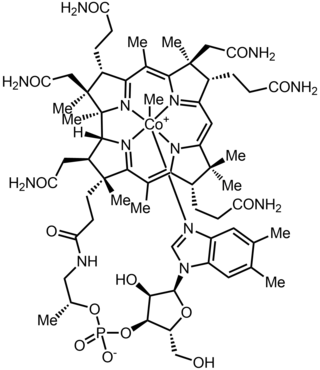| cobalt chelatase | |||||||||
|---|---|---|---|---|---|---|---|---|---|
 Putative cobalt chelatase monomer from Desulvobrio vulgaris. [1] | |||||||||
| Identifiers | |||||||||
| EC no. | 6.6.1.2 | ||||||||
| CAS no. | 81295-49-0 | ||||||||
| Databases | |||||||||
| IntEnz | IntEnz view | ||||||||
| BRENDA | BRENDA entry | ||||||||
| ExPASy | NiceZyme view | ||||||||
| KEGG | KEGG entry | ||||||||
| MetaCyc | metabolic pathway | ||||||||
| PRIAM | profile | ||||||||
| PDB structures | RCSB PDB PDBe PDBsum | ||||||||
| Gene Ontology | AmiGO / QuickGO | ||||||||
| |||||||||
| Cobalt chelatase, CobT subunit | |||||||||
|---|---|---|---|---|---|---|---|---|---|
| Identifiers | |||||||||
| Symbol | CobT | ||||||||
| Pfam | PF06213 | ||||||||
| InterPro | IPR006538 | ||||||||
| |||||||||
Cobalt chelatase (EC 6.6.1.2) is an enzyme that catalyzes the chemical reaction
Contents
- ATP + hydrogenobyrinic acid a,c-diamide + Co2+ + H2O ADP + phosphate + cob(II)yrinic acid a,c-diamide + H+
The four substrates of this enzyme are ATP, hydrogenobyrinic acid a,c-diamide, Co 2+, and H2O; its four products are ADP, phosphate, cob(II)yrinic acid a,c-diamide, and H+.
The aerobic cobalt chelatase (aerobic cobalamin biosynthesis pathway) [2] [3] consists of three subunits, CobT, CobN (InterPro : IPR003672 ) and CobS (InterPro : IPR006537 ).
The macrocycle of vitamin B12 can be complexed with metal via the ATP-dependent reactions in the aerobic pathway (e.g., in Pseudomonas denitrificans ) or via ATP-independent reactions of sirohydrochlorin in the anaerobic pathway (e.g., in Salmonella typhimurium ). [4] [5] The corresponding cobalt chelatases are not homologous. However, aerobic cobalt chelatase subunits CobN and CobS are homologous to Mg-chelatase subunits BchH and BchI, respectively. [5] CobT, too, has been found to be remotely related to the third subunit of Mg-chelatase, BchD (involved in bacteriochlorophyll synthesis, e.g., in Rhodobacter capsulatus). [5]
This enzyme belongs to the family of ligases, specifically those forming nitrogen-D-metal bonds in coordination complexes. The systematic name of this enzyme class is hydrogenobyrinic-acid-a,c-diamide:cobalt cobalt-ligase (ADP-forming). Other names in common use include hydrogenobyrinic acid a,c-diamide cobaltochelatase, CobNST, and CobNCobST. This enzyme is part of the biosynthetic pathway to cobalamin (vitamin B12) in aerobic bacteria.











